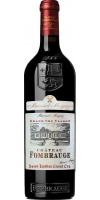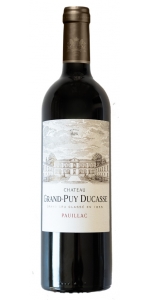Wine from Grand-Puy Ducasse

Château Grand-Puy Ducasse’s story began when Arnaud Ducasse bought a “modest“ house on the banks of the river in Pauillac in 1675. Little did he know that it would become a large estate that would remain in his family for almost three centuries. Pierre Ducasse, a lawyer with a passion for wine, considerably extended the land over three parishes - Pauillac, Saint-Lambert and Saint-Sauveur - and three seigneuries: Lafite, Latour and Beychevelle. In 1820, his son built the Château’s winery facing the Gironde estuary. At the time, this was a daring decision: Grand-Puy Ducasse would be the only Château in the area to vinify its
grapes for 200 years. In 1855, the property was included in the prestigious classification of great growths; with 40 hectares of vines spread over 11 different types of soil, its vineyard can be considered as the most representative of the diversity of Pauillac’s terroirs. Since the 1990s, major investments have been made in restructuring the vineyard. In 2004, CA Grands Crus, a subsidiary of the Crédit Agricole Group, has embarked on an ambitious optimization plan. The subsequent construction of a new vat room and barrel storage facilities completed the “Renaissance” plan. The guiding principle of Château Grand-Puy Ducasse and its teams lead by Anne Le Naour and Benjamin Cassoulet is to push rigorous standards even further.
- North of the appellation, the plots are planted on a beautiful hillside of gravel resting on a marl-limestone base. These poor, perfectly draining soils are favorable to the development of the great Cabernet Sauvignons of the Médoc.
- In the center, the historic plots in a lieu-dit called Grand-Puy, on gravelly-sandy soils on a clay base, are ideally exposed. The pebbles store heat during the day and release it at night. Great Cabernet terroirs.
- South east, a plateau of young Cabernets planted on sandy-gravelly soil on a clay base are the future of the property.
- To the west, the area called “Artigues” (which echoes the name of the property during the 1855 classification) is made up of sandy soils on a clayey-gravelly subsoil. It is perfectly suited to the estate's Merlots.
- To the South-West, podzolized soils on a clayey subsoil bring a touch of freshness and fruitiness to the Merlots and Petit Verdots.
A detailed knowledge of the terroirs made it possible to enhance the adequacy of the plant material to the terroirs. The varietal breakdown of the vineyard consists of Cabernet Sauvignon (59%), Merlot (36%) and Petit Verdot (5%). Pruned in double guyot, the vines have an average age of 25 years.
At Château Grand-Puy Ducasse, they strongly believe that it is necessary to combine quality and sustainable development. In 1996, they decided to stop weeding the vineyards and returned to tillage on 100% of the surfaces. In 2012 an Environmental Management System was implemented. 2014 marked the first experiments in organic farming and 2016 was the first Iso 14001 & HVE3 normed certified vintage. Since then, the agroecological infrastructures have been traced every year and the action plan updated to keep up with their preservation and development.
Château Grand-Puy Ducasse will seduce lovers of great red wines from Pauillac with its exceptional quality marked by a very beautiful aromatic richness. A classic vintage, complete, complex, rich and unctuous, this cuvée promises superb aging potential.
Aging 18 months in French oak barrels (35% new for the 2020 vintage).After manual harvesting in crates and an initial sorting in the vineyard, the grapes are sorted again using the latest generation optical sorting system. Vinification is then carried out in stainless steel temperature controlled tanks however for some of the batches, malolactic fermentation is also carried out in new barrels.
- back
Selected Options
Wineries
Categories
Pricing
Countries
Regions
Grape Types
Wineries
Organic/Free Shipping
Aromatically the wine lifts from the glass with a combination of perfectly ripened red and black fruits, with a graphite smokiness and a hint of mulling spices. On the palate, their is a youthful tannic structure and a floral flavors alongside the fruity notes.
Spicy cologne lifts from the 2021 Pinot Noir Paul Gerrie Vineyard, with both high-toned and darker notes of sage, menthol, bergamot, and cranberry cocktail. Medium to full-bodied, it’s tightly coiled, with tremendous length, gripping ripe tannins, a bright spine of acidity, and mouthwatering salinity that lasts long on the finish. It offers up great mineral texture and will need 3-5 more years in bottle.
- Jeb Dunnuck 96 Points
Luis Canas Rioja Blanco is made from 90% Viura and 10% Malvasia (60+ years old vines)
Barrel fermented for 3.5 months in new French oak barrels.
Alcohol: 13,5º
Total acidity: 6,5 g./l.
Volatile acidity: 0,25 g./l.
PH: 3,40
Free SO2: 25 mg./l.
Grapes harvested in small boxes to be selected manually on the table, bunch by bunch.
Beautiful golden yellow, with bright lemony highly-luminous reflections. The nose is fine, with great elegance, combined with floral and fruity tones.
The palate is dry with a crisp acidity that gives its freshness and vivacity, a structured and tasty finish of ripe fruit.
We recommend that you taste it at 8°C.
It is appropriate to accompany shellfish, crustaceans and grilled white fish or fish stews. It also blends elegantly with rice, soft cheeses, blue cheeses, all kinds of mushrooms and fresh fruit.
Review:
Wonderful punchy lemon and jasmine aromatics are softened by subtle almond and flinty mineral characters that seep into the buttery texture and stirring saline length.
-Decanter 96 Points





